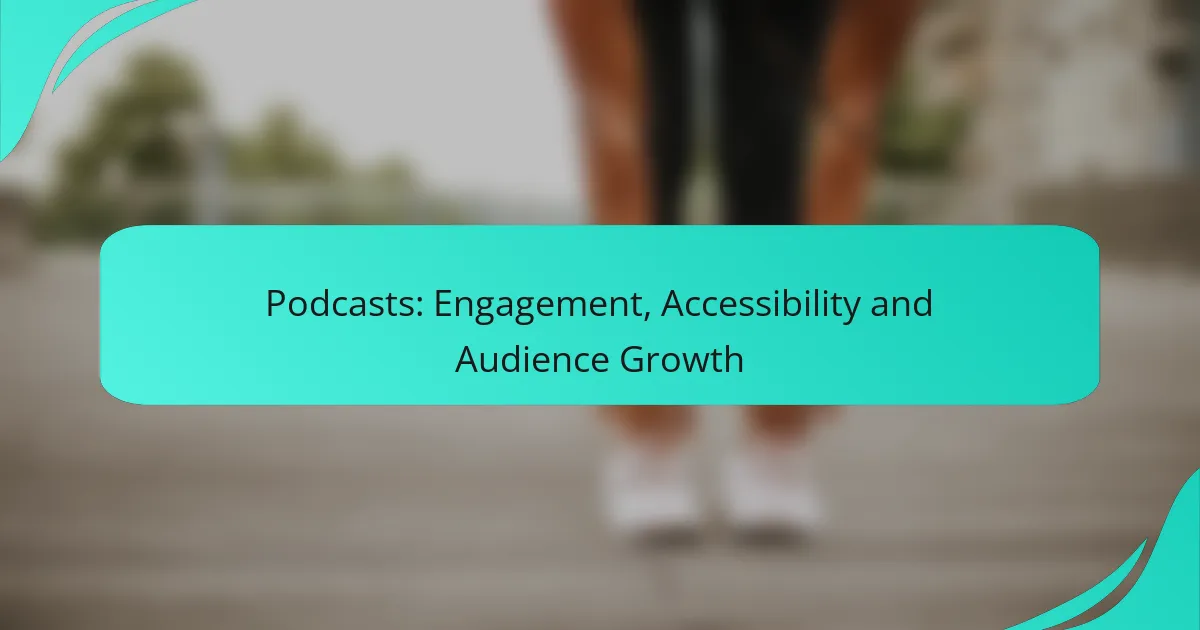Podcasts have emerged as a powerful medium for enhancing audience engagement, offering a personalized experience that fosters deeper connections with listeners. By prioritizing accessibility through strategies like transcription and multilingual options, podcasters can reach a broader audience, including those with disabilities. Additionally, effective marketing and collaboration can drive audience growth, making podcasts an essential tool for building a loyal listener base.

How can podcasts enhance audience engagement?
Podcasts can significantly enhance audience engagement by creating a more interactive and personalized experience for listeners. By incorporating various features and strategies, podcasters can foster a deeper connection with their audience, leading to increased loyalty and participation.
Interactive features
Interactive features in podcasts, such as polls, quizzes, and live Q&A sessions, can greatly enhance listener engagement. These elements invite audience participation, making them feel more involved in the content. For example, a podcast might use social media platforms to conduct polls about future topics, allowing listeners to influence the show’s direction.
Additionally, integrating technology like augmented reality or companion apps can provide a richer experience. This could include visual aids or supplementary materials that listeners can access while enjoying the podcast, further deepening their engagement.
Listener feedback integration
Incorporating listener feedback into podcast episodes is crucial for building engagement. Podcasters can encourage reviews, comments, and suggestions through various channels, such as social media or dedicated email addresses. This feedback can then be used to tailor content to audience preferences, making listeners feel valued and heard.
For instance, addressing listener questions or comments in subsequent episodes not only acknowledges their input but also fosters a sense of community. This practice can lead to higher retention rates and a more dedicated audience base.
Community building
Building a community around a podcast can significantly enhance audience engagement. This can be achieved through social media groups, forums, or live events where listeners can interact with each other and the hosts. Creating a space for discussion allows fans to connect, share ideas, and feel part of something larger.
Moreover, hosting events, whether virtual or in-person, can strengthen these community ties. Engaging with listeners directly fosters loyalty and encourages them to promote the podcast within their networks, expanding the audience further.
Personalized content
Personalizing content based on listener preferences can greatly improve engagement. This can be achieved through data analytics that track listener behavior and preferences, allowing podcasters to tailor episodes to specific interests. For example, a podcast might segment its audience and create specialized content for different groups, enhancing relevance.
Additionally, personalized recommendations based on previous episodes can encourage listeners to explore more content. This strategy not only keeps the audience engaged but also increases the likelihood of them sharing the podcast with others, driving organic growth.

What strategies improve podcast accessibility?
Improving podcast accessibility involves implementing strategies that make content available to a wider audience, including those with disabilities. Key methods include using transcription services, offering multilingual options, and enhancing audio quality.
Transcription services
Transcription services convert spoken content into written text, making podcasts accessible to individuals who are deaf or hard of hearing. Consider using automated transcription tools or professional services to ensure accuracy. Providing transcripts can also enhance SEO, making your podcast easier to discover.
When selecting a transcription service, look for options that support various audio formats and offer quick turnaround times. Many services charge based on the length of the audio, so budget accordingly, typically ranging from $1 to $3 per minute of audio.
Multilingual options
Offering multilingual options allows podcasts to reach non-English speaking audiences, significantly expanding your listener base. This can be achieved by providing translations of episode descriptions, show notes, and even audio content in different languages.
Consider hiring bilingual hosts or voice actors for localized versions of your podcast. Alternatively, you can use dubbing or subtitling for translated audio. Be mindful of cultural nuances to ensure the content resonates with diverse audiences.
Audio quality enhancements
Enhancing audio quality is crucial for accessibility, as poor sound can hinder comprehension. Invest in quality microphones, soundproofing, and editing software to produce clear and crisp audio. Aim for a balanced mix that avoids overly loud or soft segments.
Additionally, consider using audio processing tools to reduce background noise and improve clarity. Regularly solicit feedback from listeners to identify areas for improvement, and remember that clear audio benefits all listeners, not just those with hearing impairments.

How can podcasts drive audience growth?
Podcasts can significantly enhance audience growth by creating engaging content that attracts listeners and encourages sharing. By leveraging effective marketing strategies, collaborations, and social media, podcasters can expand their reach and build a loyal audience base.
Effective marketing campaigns
To drive audience growth, effective marketing campaigns are essential. This includes identifying target demographics and tailoring promotional efforts to resonate with them. Utilizing email newsletters, paid ads, and partnerships with other media can amplify visibility.
Consider running targeted campaigns during key moments, such as launching a new season or episode. Engaging storytelling in marketing materials can also capture potential listeners’ attention and encourage them to tune in.
Collaborations with influencers
Collaborating with influencers can broaden your podcast’s audience by tapping into their established follower base. Choose influencers whose values align with your podcast’s themes to ensure authenticity and relevance.
Joint episodes, guest appearances, or social media takeovers can create buzz and attract new listeners. This strategy not only increases visibility but also builds credibility through association with trusted voices in your niche.
Utilizing social media
Social media platforms are powerful tools for driving audience growth. Regularly posting engaging content related to your podcast can keep your audience informed and excited. Use platforms like Instagram, Twitter, and TikTok to share snippets, behind-the-scenes content, and listener interactions.
Encouraging audience participation through polls, questions, and comments can foster a sense of community. Consider using hashtags relevant to your podcast to reach a broader audience and enhance discoverability.
SEO optimization techniques
Implementing SEO optimization techniques can improve your podcast’s visibility in search engines. Start by researching keywords relevant to your content and incorporating them into episode titles, descriptions, and show notes.
Creating a dedicated website or blog for your podcast can also enhance SEO. Regularly updating it with transcripts, articles, and additional resources can drive organic traffic and attract new listeners.

What metrics measure podcast success?
Podcast success can be measured through various metrics that reflect audience engagement and growth. Key indicators include listener retention rates, download statistics, and engagement levels, each providing insights into how well a podcast resonates with its audience.
Listener retention rates
Listener retention rates indicate how many people continue to listen to a podcast over time. A high retention rate suggests that the content is engaging and valuable to the audience, while low rates may signal the need for content improvement or better targeting.
To calculate retention, compare the number of listeners at the beginning of an episode to those who finish it. Aim for retention rates above 60% for episodes to ensure your content keeps listeners engaged throughout.
Download statistics
Download statistics provide a basic measure of a podcast’s reach and popularity. Tracking the number of downloads per episode can help identify trends, such as which topics attract more listeners.
Consider monitoring downloads over the first week after release, as this period typically captures the majority of audience interest. Aiming for thousands of downloads within this timeframe can be a good benchmark for a successful episode.
Engagement levels
Engagement levels reflect how actively listeners interact with a podcast, including actions like sharing episodes, leaving reviews, or participating in discussions. High engagement indicates a strong connection between the podcast and its audience.
To enhance engagement, encourage listeners to provide feedback through social media or dedicated platforms. Regularly assess listener interactions, aiming for a consistent increase in comments and shares to gauge audience investment in your content.

What are the prerequisites for starting a podcast?
Starting a podcast requires a combination of technical equipment, content planning, and understanding your target audience. These elements are crucial for creating engaging and accessible episodes that can attract and retain listeners.
Technical equipment
To launch a podcast, you need essential technical equipment such as a quality microphone, headphones, and recording software. A good microphone can range from $50 to several hundred dollars, depending on the quality you desire.
Additionally, consider investing in audio editing software, which can be free or cost up to $300. Popular options include Audacity for beginners and Adobe Audition for more advanced users. Ensure your recording environment is quiet to minimize background noise.
Content planning
Effective content planning involves outlining your podcast’s theme, episode structure, and frequency of release. Decide whether your podcast will be scripted, semi-scripted, or unscripted, as this will influence your preparation time and style.
Creating a content calendar can help you stay organized and consistent. Aim for a release schedule that fits your capacity, whether that’s weekly, bi-weekly, or monthly. This consistency helps build an audience over time.
Target audience research
Understanding your target audience is vital for tailoring your content to their interests and preferences. Conduct surveys or utilize social media to gather insights about potential listeners’ demographics and listening habits.
Identify what topics resonate with your audience and what formats they prefer, such as interviews or storytelling. This information will guide your content creation and marketing strategies, ensuring your podcast appeals to the right listeners.

How do advertising models work in podcasts?
Advertising models in podcasts primarily involve sponsorships, dynamic ad insertion, and host-read ads. These models allow podcasters to monetize their content while providing advertisers with targeted access to engaged audiences.
Dynamic ad insertion
Dynamic ad insertion is a method where ads are added to podcast episodes at the time of playback rather than during recording. This allows for real-time updates to advertising content, enabling podcasters to serve relevant ads based on listener demographics or geographic location.
One key advantage of dynamic ad insertion is its flexibility. Advertisers can change their campaigns frequently, and podcasters can optimize their revenue by inserting different ads into the same episode over time. For example, a podcast episode can feature a seasonal promotion during specific months, increasing relevance and engagement.
However, podcasters should consider the potential downsides, such as the risk of disrupting the listener experience with too many ads. A good practice is to limit ad breaks to one or two per episode and ensure they are seamlessly integrated into the content. This balance helps maintain audience engagement while maximizing revenue opportunities.
